Bayliff’s Packard Takes LeBaron Coachworks to New Heights
The Packard Motor Car Company had an impressive run as a standalone company, then as part of the Studebaker-Packard Corporation (1954), making high-end vehicles in one of the best times in American history. But we aren’t here to discuss those distant memories, nor are we discussing the controversial V-12 sedan made by Roy Gullickson in the 1990s. What’s before us is a custom-bodied convertible with a 1949 Packard title, named the Packard Bayliff Lebaron.
There’s a lot to unpack in that name, as Packard stopped making cars after 1958. LeBaron is a prewar coachbuilder that made famous bodies for luxury cars before it was folded into Chrysler, after which its name morphed into a trim level for mid-century Imperials and premium vehicles in the 1980s. Bayliff is the funeral- and custom-car maker that made what you see above. Its tribute to two long-forgotten names is currently available on Hagerty Marketplace with a high bid of $35,000.

Again, Bayliff didn’t make only this Packard; it is a famous name in coachbuilding circles. Perhaps the Bayliff LeBaron was a final tribute to the company’s coach-building heritage, as it created this vehicle sometime in the early 2000s. There was precedent for such a project, as Bayliff made a similar vehicle before it sold the Packard name to Gullickson for $50,000 in 1992 for his failed attempt to relaunch the iconic brand. (How Bayliff managed to make this Packard Bayliff LeBaron without raising the ire of Gullickson remains to be seen.)



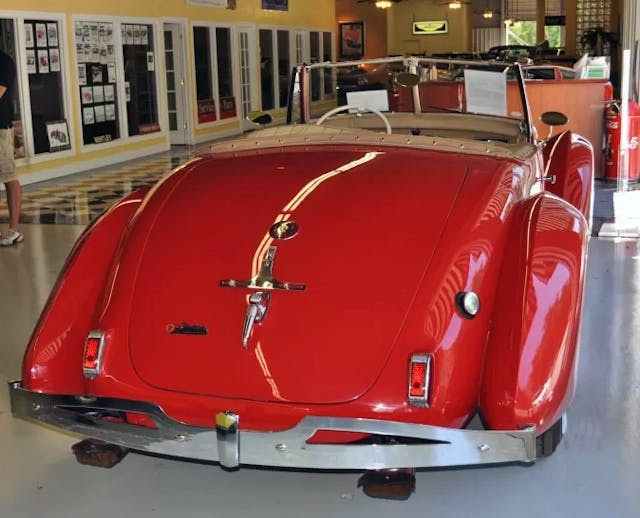
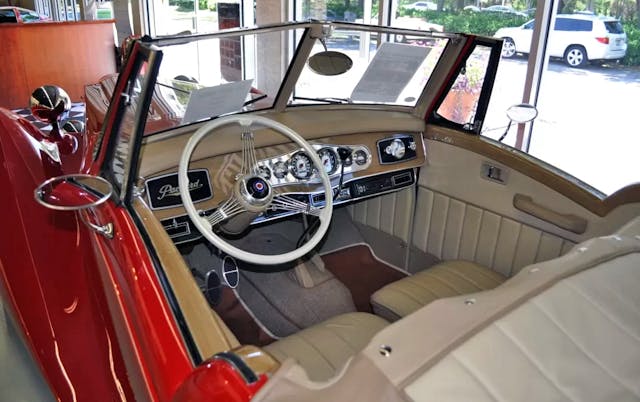

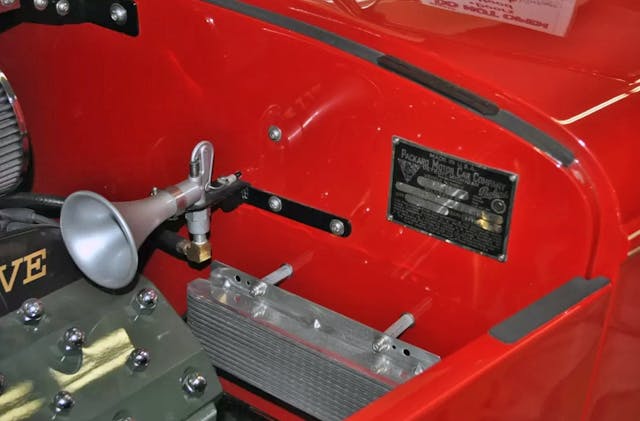

Meet the bright red “1934” Packard Bayliff Victoria (via Undiscovered Classics). This less streamlined design of this fiberglass tribute car was intended to look 15 years older than the burgundy LeBaron we are profiling today. The deeply contoured doors are the best example of the Victoria’s heritage, looking more like something from the early 1930s and less like the sleek, straight lines of the Bayliff LeBaron.
The Bayliff Victoria also appears to use fewer parts from recognizable donor cars, and it was likely made a full decade before the Bayliff LeBaron. Details are minimal and photos are vague, so this assumption is based on the audio system installed at the time of manufacture: The Bayliff Victoria’s radio looks like a 1990s vintage Kenwood CD player or similar. (The Bayliff LeBaron has a 2000s-era Sony, as seen below.)
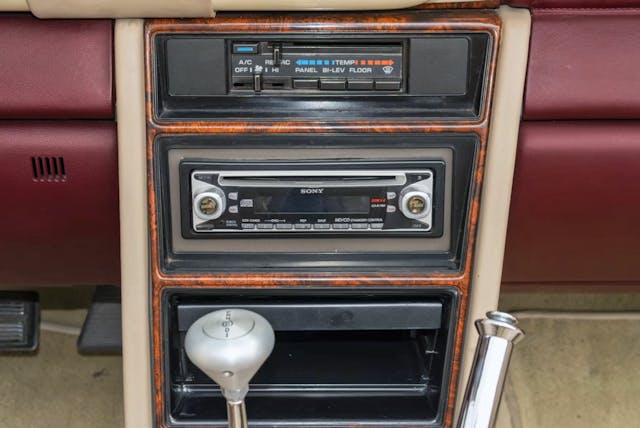



Speaking of “recognizable donor cars,” the Bayliff LeBaron used many parts from the 1987–89 Chrysler LeBaron convertible. While the use of the LeBaron name might be coincidence, there’s no doubt this long-forgotten coachbuilder found a good home on this custom Packard.
Parts shared with the Chrysler include the cowl, A-pillars, and support structure for the glass and top mechanism. The Chrysler LeBaron’s cowl also donated key interior elements, including the HVAC system, the dashboard, the center stack for the Sony radio, and a glovebox for the passenger.
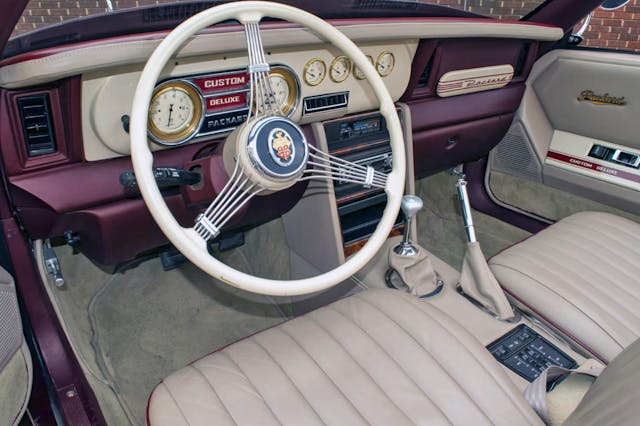

To be fair, the overall interior design feels like a worthy tribute to a classic Packard: Details like the banjo steering wheel, Lokar shifter, and upright dashboard almost feel period-correct. Only the “Packard” script pillow on the passenger side, and the “Custom Deluxe” graphics on the door panel, oversell the conversion. Perhaps some modern 3-D printing technology could make neoclassic trim panels, and a chrome-laden RetroSound audio unit could better integrate the designer’s original vision into the package?
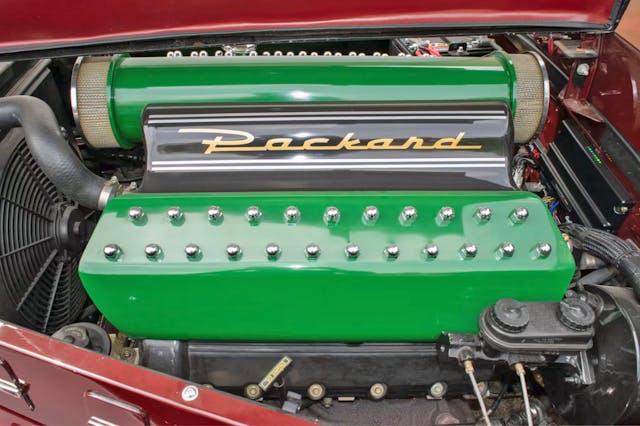
Under the Bayliff LeBaron’s long hood is a SOHC Ford Modular V-8 displacing 5.4 liters with 260 horsepower, disguised as a Packard powerplant with an engine cover that cleverly integrates two air filters. While the Lincoln Navigator’s more assertive DOHC mill wasn’t implemented in this build, the Holley EFI Terminator X system likely keeps that motor purring like that of a proper Packard. The rest of the chassis appears to have a truck-like ladder frame with rear leaf springs. This was likely by design, part and parcel of Bayliff’s roots as a funeral coachbuilder.



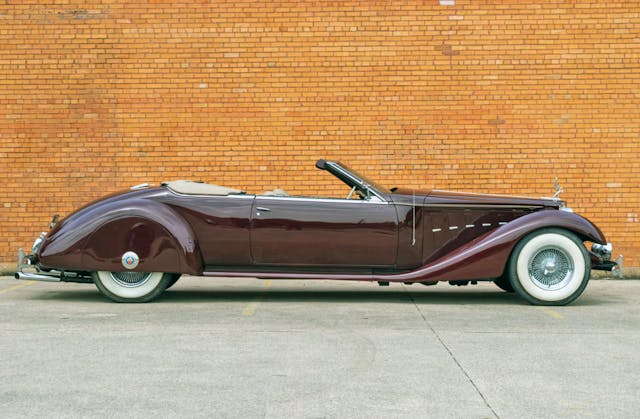
None of which detracts from the elegance of this design and the delightful audacity of its creator to bring it into existence. The 1949 Packard Bayliff LeBaron is downright stunning on its massive wheelbase, with its flowing fenders and 100-spoke wire wheels. Now that the Chrysler LeBaron convertible’s demise is almost three decades in the past, I reckon the Bayliff LeBaron can stand on its own at any car show in the country. Nobody will know what’s underneath, or where it came from.
Decades later, being a Chrysler under that burgundy paint certainly helps. The fabric top is torn in places, which can be resolved for $400 or less thanks to aftermarket support. Paint chips, fading, and swirl marks are noted in the auction, but they point to an owner who enjoyed the vehicle and didn’t let it rot in perpetual storage, and driving such a stately machine is likely what Bayliff wanted in the first place.

The oldest record of this vehicle’s sale was at Barrett-Jackson in 2005, where it sold for $79,200. It then sold at RM Sotheby’s a decade later for $71,500. Where it will land on Hagerty Marketplace at the auction’s close on Friday remains to be seen, but there’s no doubt that the next owner will be part of the storied history of the famous brand. And they will be responsible for a stunning piece of automotive coachbuilding that capitalized on the best of the word “LeBaron” from multiple decades.
***
Check out the Hagerty Media homepage so you don’t miss a single story, or better yet, bookmark it. To get our best stories delivered right to your inbox, subscribe to our newsletters.



A nice looking car, looks like it would be a lot of fun, hope the new owner drives it a lot with the top down.
I am waiting for the Packard that is coming out of Medina Ohio. The company owns the rights to the Packard brand and are planning reproductions of the original cars.
I have been to their show room and so far the one I saw looks amazing. They are still setting up and I expect them to be very expensive. It is none of this retro design on a late model Ford.
Not sure they will last long but imagine what it would be like to buy a new Packard.
You should check out the Packard Myth, a boattail coupe made by noted Cadillac and Packard restorer Fran Roxas, and designed by ex GM designer Strother MacMinn that was a Great Eight finalist for the Ridler Award at the Detroit Autorama.
The windshield rake is the key to IDing the DNA of the LeBaron LeBaron. Aside from that, not a bad looking car.
The red Victoria reminds me of the old Clenet with its my midget windshield frame, but here the windscreen gives off a late 30s Mercedes vibe. The front however, looks
Like a fiberglass MD TD replica.
The Packard twelve prototype shown in one picture looks like a Lincoln Mark VIII that melted a bit in the sun with some funky headlights.
Bayliff’s car looks good.
Bordering on Excalibur-like tackiness . . .
Thank you, PD. And the above contortion is stupid on so many levels. First, it’s a Ford. The heart, soul of an automobile is its engine. It’s bad enough that dim bulbs too ignorant, too lazy, to learn about the genuine article are putting crate Chevy V-8s, Turbo Hydramatics, tilt wheels, big chome wheels in and on what used to be mid-30s senior Packards and a ’34 Pierce-Arrow 8 club sedan, but now hewing to fanciful bolshoi like the above.
Sorry. No, no, and no. Either rebuild the real thing, or buy another “retro rod”/Frankencar. A respectful “continuation,” casting a faithful copy of the original engine block, heads, manifold(s), duplicating the original transmission, everything, as Pur Sang, Parana, Argentina is authentically reproducing prewar Alfa Romeos and Bugattis, would be acceptable, but there are still plenty of senior Packard 8s and V-12s around, and dozens of American suppliers of parts and services.
And really, what’s with the look at me/resale red? Consult Packard paint charts from the ’20s through ’40s, and spare us the lame excuse of “you could get any color if you paid extra for it,” because other than fire chiefs, no one had Tonka Toy kolor like the above.
Speaking of colora, A friend is a fairly well known Pierce Arrow restorer/collector.
He has a rare ’30-something convertible.
When he painted it, he did a two-time in gray-red.
He did it for modern appeal, which he later regretted. He told me “it looks like a clown car, no one would have finished a car in those colors back then”.
John, exactly. There are too many circus wagons out there as it. An ophthalmologist ’33 Pierce V-12 conv. coupe owner told me he circa late ’80s, ’90 put several of his leading contender colors against a black background, the better to see them, before making his final selection, a tasteful light apple and darker mint green two-tone.
Your friend will well know about Seagraves using Pierce’s 462-ci V-12 bumped out to 530-ci in their fire trucks through 1970, but many don’t realize Pierce’s 385-ci straight eight used as was by Seagraves into 1959. Both engines were given twin ignition because such mandatory in emergency equipment.
This Pierce 8 of the ’30s was monobloc, with Pierce’s invention, hydraulic valve lifters, ’33 on. The same dimension Packard Super Eight and Chrysler Imperial inline L-head 8s of that time had separate block and crankcase, mechanical lifters. Packard’s Twelve, the same design as the Auburn Lycoming V-12, used GM’s complicated hydraulic valve silencers under license.
’30s Pierces, 8s or 12s, nonpareil. Last generation of each 1936-38 overdrive standard. Hope your friend gives you a ride in it.
I’m more interested in the Packard 12 prototype from 1992. While the initial impression is “ugly, kit car Lincoln”, I read into it and it was a ground up aluminum platform with a 440HP 8.2L V12 tha got to 60 in 4.8 seconds. Absolutely incredible. Unfortunately, that goofy retro styling was not where luxury was in the early 90’s. The LS had already been a big hit for being bland, high quality, and well priced. But I applaud the effort.